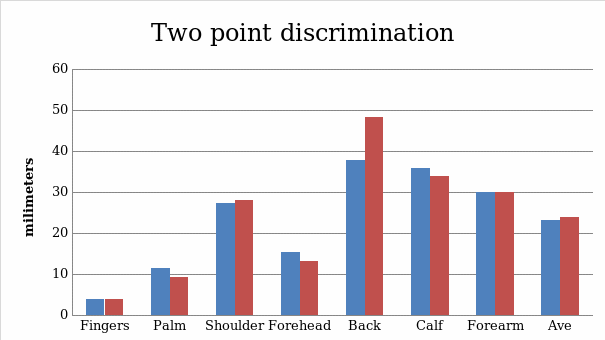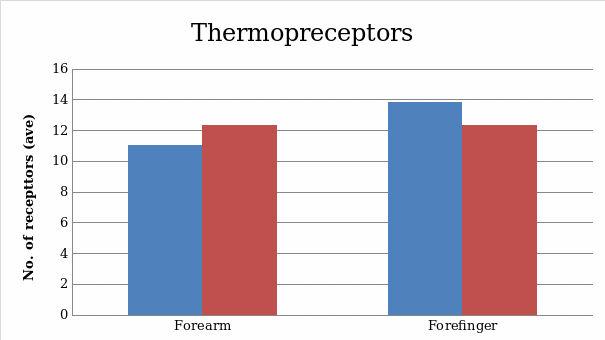The somatosensory system is a complex combination of neurons and pathways that allows humans to respond to changes occurring on the surface of their body. The more specific element of this system examined in this laboratory experiment is cutaneous receptors, responsible for detecting mechanical pressure, potential damage, and temperature change. The physiology behind the experiment is the response of a receptor to stimuli from the external environment. This produces a nerve impulse that conveys information about the place and nature of the stimuli. The purpose of the experiment is to test two-point discrimination, localization of touch, and thermoreceptors and determine their response to various stimuli.
The hypothesis is that the human body can perceive two distinct stimuli as separate, localize a specific area of impact on the surface of the body, and distinguish between hot and cold temperatures. It is because of the two-point discrimination and general somatic afferent. Other relevant research on the topic was conducted by Chuquilin, Alghalith, and Fernandez (2016), Jänig (2018), and Shigeo (2015). The aim is to observe the response of mechanoreceptors and thermoreceptors to touch and temperature change on a human subject. The hypothesis is that cutaneous receptors help detect different stimuli, localize them, and distinguish between different temperatures.
Methods
Due to the fact that three types of receptors were tested during this experiment, the methodology for each differs an is detailed below. No deviations from the methods outlined in the manual were necessary. Firstly, to test the hypothesis regarding the two-point discrimination, the individual’s arms were placed on the bench in a relaxed position. Two-point compass was used to stimulate a finger gently, and different separation of the compass helped determine the proximity and response. For the ascending experiment, the detachment of the two-point compass was set at the minimum, while for the descending trial it was set at a maximum. When the participant reported feeling two distinct stimuli in the ascending experiment and one stimulus in the descending test, the distance set on the two-point compass was recorded.
In the second experiment, the localization of touch was tested using a felt tip pen and a pencil. The researcher marked the back of the non-preferred hand, and the participant tried to point to the same spot. Two trials were done for each body part, including hand, forefinger, and forearm. The error distance, which is a difference between the point marked by the felt-tip pen and the one which the participant showed was recorded for each trial. In the third experiment, temperature probed filled with ice water, and hot water was used on the 1 cm by 1 cm square on the forearm and forefinger. The participant had to report whether touch, cold, or warm temperature is felt.
Results
We observed that the minimum separation distance where the participant was able to detect two sharp points on the right forearm was 3,71 on the left fingers. The maximum separation distance where the participant reported was 48 on the back. All the recorded results can be seen in Graph 1. In the localization of touch, the error in millimeters was logged when measuring the difference between the stimuli position and that to which the participant pointed. In the back of the hand, the result was estimated at 10, 67mm while on the forearm it was 17,33mm. The forefinger area presented the least significant error with a deviation of 4,38 mm. Graph 2 demonstrates the findings of this experiment including the data regarding the error and area tested.


In the final experiment, the response of the receptors to temperature change was tested. Graph 3 demonstrates the findings, including the temperature – hot or cold, area tested – forearm or forefinger, and the number of specific receptors. It was detected that in the forearm, there are more hot receptors with a result of 12,33 while the number of cold receptors is 11. A different case can be observed in the forefinger area where there are 13,83 cold and 12,33 hot receptors.

Discussion
Cutaneous sensitivity is crucial for humans because it allows convening external information such as temperature or vibration into nerve impulses. This will enable people to distinguish between specific stimuli, using different types of receptors. The physiological reasoning for the results are connected to the nature of cutaneous receptors, their mechanisms of action, and respond to stimuli. Chuquilin et al. (2016) state that the skin has various types of nerve fiber endings that serve different purposes. For instance, nociceptors are capable of reacting to pain, while mechanoreceptors respond to the pressure of mechanical impact on the surface. This experiment aimed to test several hypotheses regarding cutaneous receptors and their mechanism of actions.
The results of this study support the hypothesis that the peripheral regions are the most sensitive to tactical stimulation because they have the most significant cortical representation. The only areas that presented a conflicting finding in this regard are shoulders and back. In the first trial, the neurophysiological mechanisms responsible for the two-point discrimination were tested. Based on the results one can conclude that the density of afferent receptors is the critical factor that impacts this element.
The error of localization of touch is less in one part of the body when compared to the other because of the density and size of the receptor fields. The perceived localization of touch is a complex process that involves detecting a stimulus, transmitting the signal, and analyzing it within the cortex to determine the place of impact. The size of receptor fields has a critical role in this process because the combination of these elements impacts the sensitivity towards stimuli. Thus, when the sensory receptive field units are narrow, the more accurately an individual can identify the place of stimuli. Additionally, this process correlates with the sensory fibers connected to the brain and lateral inhibition.
Thermal receptors are adapting slowly because they are firing through the duration of the stimulus. The spatial discrimination of thermal receptors in the process of distinguishing between two separate stimuli, in this case, is hot and cold. Thermoreceptors respond to the specific impact and help a person determine the temperature of the environment or an object. The experiment described in this report helped establish the number of hot and cold receptors in a different area of a human body and conclude that their presence allows individuals to determine the temperature. In general, the findings of this experiments are consistent with the physiological theory and support the hypothesis that people can perceive two separate stimuli simultaneously, localize the point of touch, and determine the temperature of an object.
References
Chuquilin, M., Alghalith, Y., & Fernandez, K. (2016). Neurocutaneous disease. Journal of the American Academy of Dermatology, 74(2), 197-212. Web.
Jänig, W. (2018). Peripheral thermoreceptors in innocuous temperature detection. Handbook of Clinical Neurology, 156, 47-56. Web.
Shigeo, K. (2015). Temperature receptors in cutaneous nerve endings are thermostat molecules that induce thermoregulatory behaviors against thermal load. Temperature, 2(3), 346-351. Web.